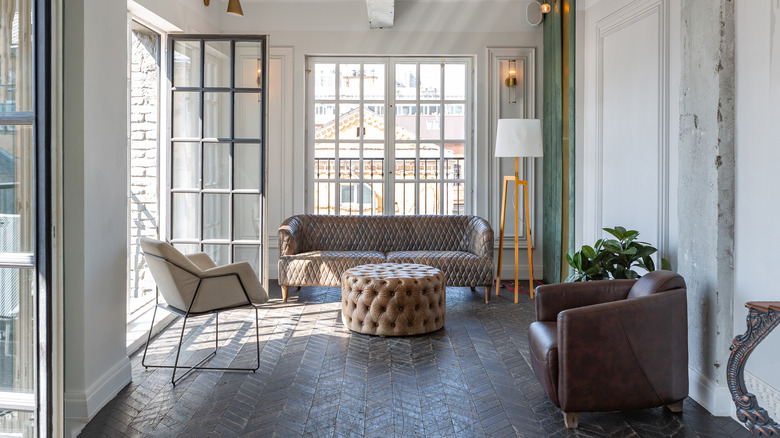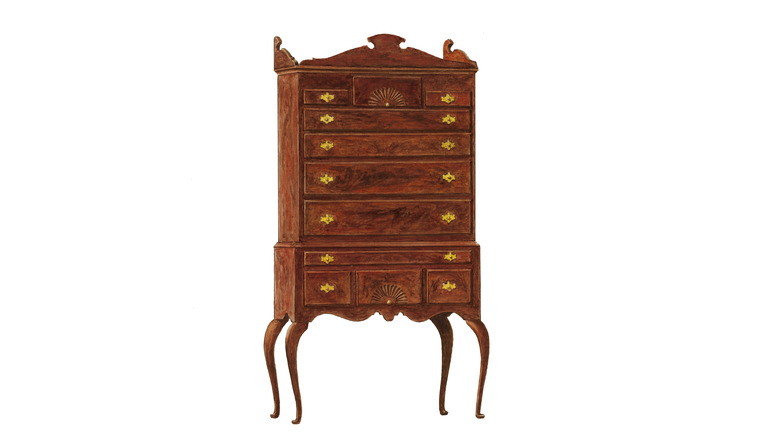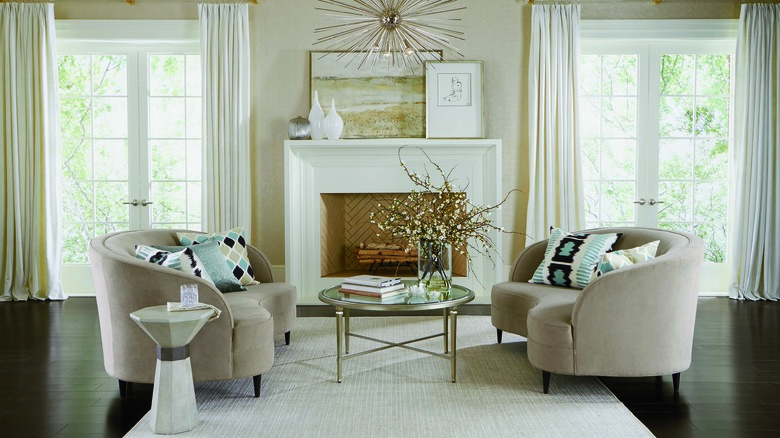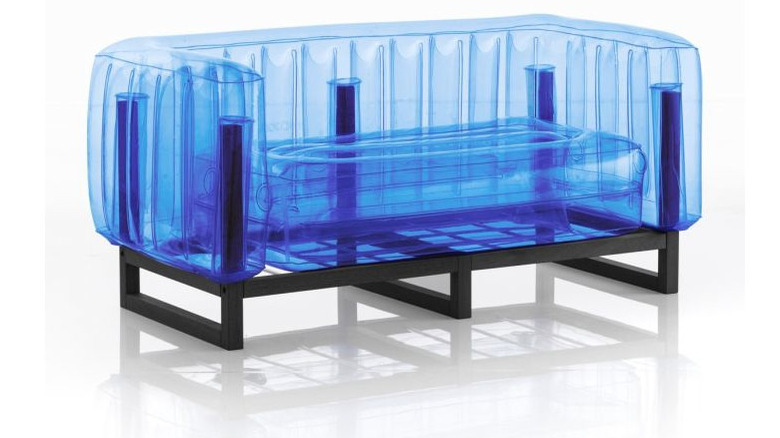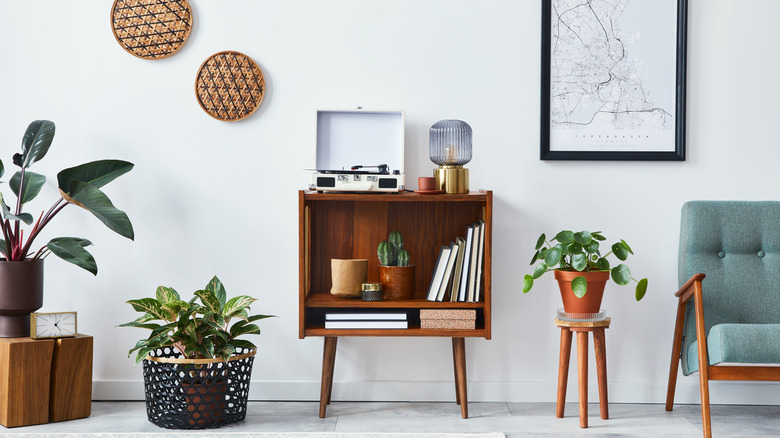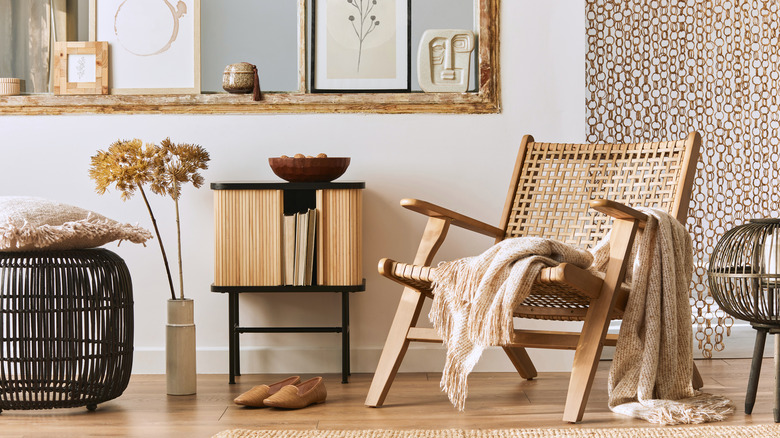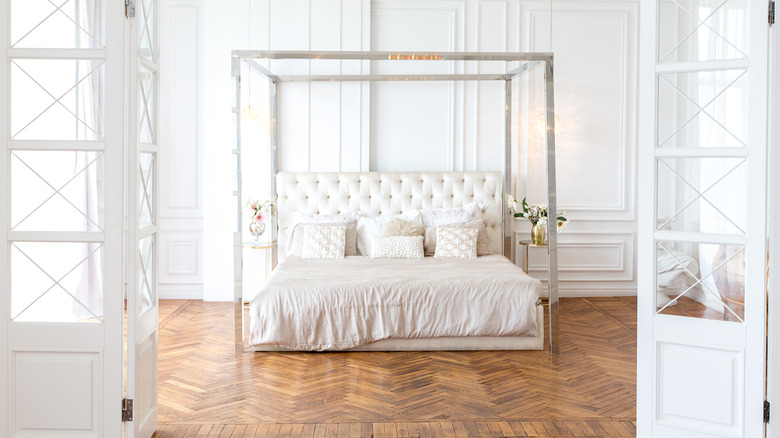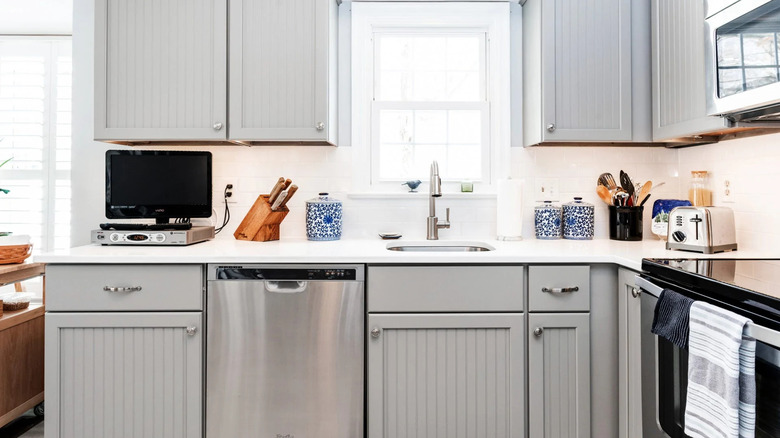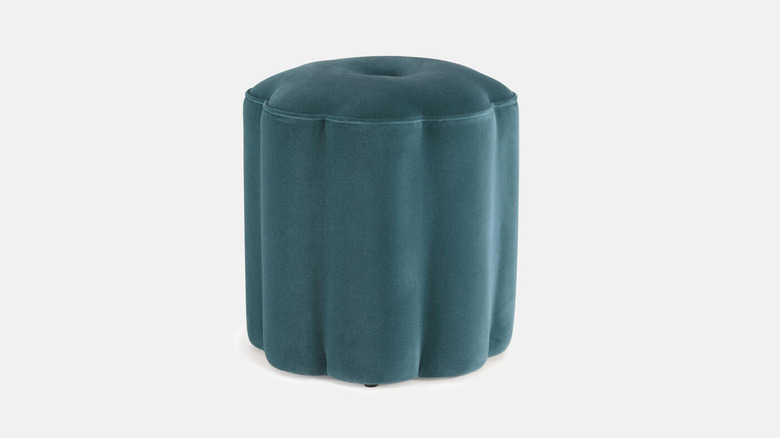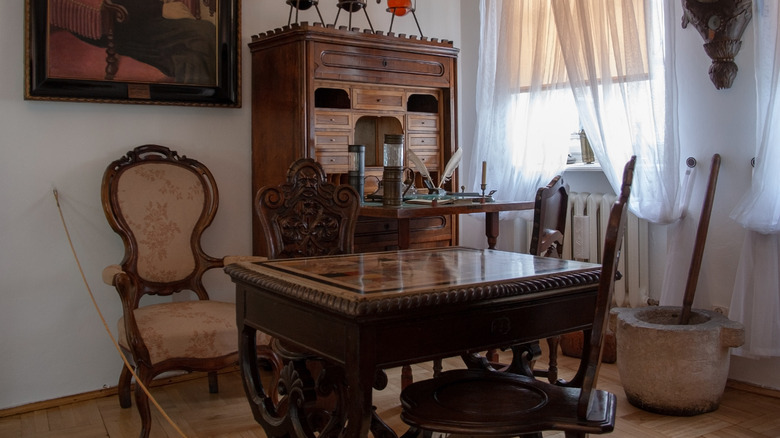Outdated Furniture Pieces That Are Having A Comeback
If you've had the experience of being around teenagers and thinking you've stepped back in time and into The Breakfast Club, you've come face-to-face with the cyclical nature of style. This can be pretty startling for those of us who are old enough to remember the last round... no one wants to feel vintage. Though according to National Appraisal Consultants, vintage can mean anything 20 years or older... more recent than the introduction of the DVD. There's a pretty good chance that you know someone, or are someone, who has the same haircut now as in 1999. Vintage is only old if you're very young.
But a lot of people aren't even seeing the cycle; to them, this is all fresh and wonderful. David Thompson says we should try to recapture that excitement, and even cultivate it by seeking out pieces even older than the current trends are pushing (via Nature World News). What your parents or grandparents would consider old can be perfectly new to you. And if there's an overarching trend in furniture right now, it's sidestepping the trends and making things about your personal preferences, needs, and style.
For furniture, what's out is style as a cohesive set of rules. You might have a palette, but it won't be all white (via Michael Helwig). You might incorporate the simplicity of a Scan design piece, but not in a context of stark minimalism. On the other hand, some trend watchers who are proclaiming the end of minimalism have taken to proclaiming the rise of maximalism, as if you can't have anything in between (via Lakdi), and that's not right either. What seems to be taking hold is spaces that are lived in, having neither too little nor too much stuff to function, and styles that are timeless, which involves (among other things) avoiding the extreme and the novel in favor of the universal.
The most important thing in the room is people
The personalization implied by these trends throws the very concept of "trend" out the window, at least in part. While people continue to love and choose mid-century modern furnishings, for example, others will have the freedom to find an era they love (art deco, perhaps, or Victorian) and concentrate on curating pieces from that period, says New York Design Agenda. This will blur the trendlines into each other.
When the current cycle began to take shape, trend watchers understandably looked to COVID-19 as a factor. In an uncertain economy and spending more time than ever at home, we poked around in our attics, our parents' attics, and the vintage goods marketplace for inspiration. What we found was furniture that was cozy, unselfconsciously ornate, and generally more amenable to around-the-clock living than the starkness of mid-century modern minimalism. What we found also happened to be around the corner, unencumbered by supply chain bottlenecks and various sorts of shortages that the commercial interests were struggling with. Shortcutting those bottlenecks further confounds businesses, who rely on selling products during a sweet spot between current fashion and "daring" ideas a year before their time (via Basecamp's Signal v. Noise blog).
Trends can also be expansions of influence from other areas of life. Sustainability is on almost everyone's list of furniture fashion trends, which might revolutionize the very meaning of style along the lines of "slow fashion," a term coined by textile consultant Kate Fletcher to describe a clothing fashion movement promoting environmental consciousness and economic fairness, and resulting in collections that are intentional, higher-quality, timeless, curated, and multifunctional (via The Ecologist)... all of which are also characteristics of today's furniture trends.
Queen Anne highboy (and similar)
In a way, the re-emergence of Queen Anne and Victorian styles are poster children for the movement as a whole/ We are bringing in older and more decorative pieces that we love because we love them. The Queen Anne highboy is just an example of this: a comfortable piece of practical furniture that looks great in an eclectic setting and can serve about as many purposes as there are things to put in it. These pieces tend to be of higher quality than recent mass market items and work well mixed with modern pieces, according to Auction Central News.
Stephanie Smith, co-owner and COO of Rhode Island-based furniture retailer Chariho Furniture, says the Queen Anne period is a good representation of traditional furniture that contrasts with the cleaner lines of modern designs. "People are mixing in that traditional and classic, like Queen Anne highboys with their contemporary, so they have a skirt on their sofa, but it will have a little bit of a flare on its arms," says Smith (via The Providence Journal).
The Queen Anne highboy represents a larger trend toward reintegrating Queen Anne and Victorian furniture into modern homes, which finds expression in far more than just highboys. Smith describes ornate, comfortable chairs and dining tables with gracefully curving legs as other examples of the trend.
The curvy couch
But no mere table legs can curve like the curviest of curves, the curvilinear couch, and it's making a comeback too. Reports of the death of the boxy sofa have been greatly exaggerated, but there's no question that curves are having a moment. Carla Aston spotted many examples of the curvy couch and related capsule and arch shapes at the 2022 High Point Market furniture industry trade show.
Blogger Chloe Dominik says curved couches are making a comeback because they are dramatic focal points of a room, they are more amenable to intimate conversation, and they are essential art pieces (via the Chloe Dominik blog). Like the Queen Anne highboy, Dominik says the curvy couch represents a larger trend in furniture... in this case, a trend toward more curved furniture in general. Design consultant Elisabetta Rizzato says the trend aims to counteract two years of pandemic-related worries and adjustments by making the home a bit more comfortable, softer, and happier. Rizzato also says this is part of a larger trend she calls Playful Living (via Italian Bark).
Inflatable furniture... again already?
Playful living can go to extremes, but that's not necessarily a bad thing. And you're not going to get a curvier couch than one that can double as a floating pool lounger. "Everything looks inflatable now," says Minnidip's Emily Vaca (via Architectural Digest). But it's not all just about play; there's something for everyone, except perhaps cat owners. Some designers have attempted serious sculptural elements that are inflatable, as well as commercial elements and lots of items that can be used for various purposes. Some can even be sat upon, assuming they are currently where you want to sit; they do tend to move around a bit.
The inflatable furniture space is maturing, though still perhaps with too many punny company names and too many wind-blown models showing off the various options. Blofield offers some fairly conventional seating, except for all the air, and Nap Pak's inflatable sleeping shelter looks like something everyone should have in the trunk of their cars. Meanwhile, since fashion is never to be wholly unserious, Recycool has developed a line of alien larvae with chrome legs and little eight ball feet, which turn out to be chairs made of recycled inner tubes (via If It's Hip, It's Here).
The media console
For a few decades now, entertainment center furniture has mostly been useful as something to buy second-hand and turn into a play kitchen for your toddler. Then along came the repurposed armoire... its new purpose being to hide a tangle of hideous media gadgets inside gargantuan furniture that at least disrupted the ever-eclectic dorm room remnant decorating style. But now there's hope. In a streaming world, there's less media to store, and towers of electronics have been replaced by devices that can be the size of a USB thumb drive. TVs have grown in breadth and slimmed in depth to the point that they're almost always wall-mounted, leaving room for purpose-built furniture that shows off beautifully designed audiophile amplifiers and turntables. Symbol Audio says it's time for the return of the 1950s all-in-one media console, and it might have been that time for a while. TrendHunter, perhaps unsurprisingly, spotted the trend of "era-spanning sound systems" in 2012, and it's now readily apparent in the collections at places like West Elm.
To be sure, the entertainment center never went away, but it has morphed into a mid-century sideboard, low and wide and able to stand on its own merits regardless of the buffet of media delights it contains, or the simple console table that does a beautiful job of keeping an amplifier off the floor without overpowering the amp's own built-in style.
Incidentally, the recent furniture trends are not just good for audiophile style, but for audio quality as well. Audiophile pluralist John Darko explains that the hard, smooth surfaces of minimalism reflect sound and are bad for a room's sound quality (via Darko).
Woven is me: wicker and rattan sneak back in the door
One unexpected way to bridge the chasm between minimalist and homey is wicker and rattan, which Hommes Studio says add style without a lot of visual weight. If you're cringing, or thinking of lawn furniture, bear with us. As we said at the outset, cyclical design trends don't tend to cycle through the same people every time. Oh, you might welcome high-waisted mom jeans back, but you haven't quite recovered from the first go-'round with wicker and have more or less permanently relegated it to the sun room or wherever else you might have relegated artifacts that remind you of British colonialism on the Indian subcontinent. But others don't necessarily have negative connotations about eighties interior design associated with wicker, and so are more open to the trend. And they're bringing others with them. Only a couple of years ago, Elle Decor had wicker on a list of trends it hoped never to see resurface. In September of 2022, rattan hanging chairs were at the top of Elle's Trends webpage.
But hang on. Isn't this just a case of fashionistas being fickle? Well, no. The new rattan doesn't just disappear into the background. It is integrated with rectilinear modern elements to soften and warm them, and even repurposed vintage pieces are survivors of a process during which the more dated elements have been culled (via Emily Henderson).
Canopy beds
Okay, maybe it's not fair to say that canopy beds were ever truly "outdated." They have a timeless quality, and certainly never went away. Beds are a highly personal comfort item, and probably not as prone to being discarded with an annual refresh the way other furniture might be. Which is just as well, since the canopy bed appears to be making a comeback as a front-of-mind design trend.
According to Studio McGee, a canopy bed adds height and provides a focal point in a room that would otherwise be largely occupied by a big, flat plane. And it's possible that the pandemic refocused adults on the master bedroom as a place to escape from the uninterrupted attention of other family members (via the National Association of Realtors). Interestingly, modern canopy beds often don't include an actual canopy. Not a single canopy bed featured by Studio McGee includes a cloth canopy element. Canopy beds are available in a variety of styles, including standard minimal metal frames, more monumental wood, lighter frames with rattan elements, and even some with actual sheer fabric canopies (via Lori Dennis).
Decorative cabinetry
After what seems like 50 years of open shelving and bits of furniture like console tables being used as kitchen cabinets, interior designers are predicting the return of cabinetry... and specifically, decorative cabinetry. Expect to see more elaborate takes on the classic Shaker-style lines that have defined the space for so long, according to Best Online Cabinets. The simplicity of basic raised-panel cabinet door design is the stuff timelessness is made of, so it's no surprise that designers won't yet fully abandon it. So, ornate cabinetry is a matter of degree, and "decorative" in this context might mean something as simple as vertical panel beading or elaborate hardware.
The trend toward the ornate in the larger furniture universe is less subtle. Designers like Caitlin Higgins and Emily Henderson, winner of HGTV's Design Star competition, are spotting everything from the merely quirky and colorful to elaborately carved antiques (via Style By Emily Henderson). If that's design at a rolling boil, expect cabinets to be at a simmer, which is just about right.
Soft sculpture: padded, fabric-covered pieces
Pieces like ottomans, footstools, and poufs in idiosyncratic shapes and covered with surprising fabrics are suddenly a thing. Except that it's not so sudden; like the decorative cabinetry, this is another design evolution by degrees. Fabrics might include boucle, wool, canvas, or sisal. But, you're thinking, I've read that boucle is on its way out. Maybe. Designers and trend watchers have declared the tyranny of boucle over; meanwhile, Etsy reported an 83% increase in searches for boucle chairs, sofas, and ottomans for the first quarter of 2022.
The teardrop ottoman might remind you of the curvy couch, and that's no accident (via Holly Hunt). But you have a little more latitude with fabrics and textures, and some might go for a splash of color here, as that will probably make cleaning (or failing to clean) the kids' snacks and inevitable tracked-in dust less onerous.
Secretary desks
As the work-from-home trend settles into its long-term form, many are starting to formalize work's role, sort of the home version of corporate space allocation, but without the cubicle walls. For a lot of jobs, and for just paying your bills, you don't need a lot of space, but you do need a way to close down for the day and return to your home to full home mode. Enter (or re-enter) the secretary desk. This is what the multifunction furniture trend always wanted to be: a piece that changes into a different piece based on the need.
This fairly simple device is basically a cabinet upon which is mounted a hutch with a built-in leaf that drops down or folds out to form a writing surface, says 1stDibs. They have become extremely popular in all of their forms, from wall-mounted boxes you might use as a mail sorting center to grand Chippendale masterpieces with Queen Anne legs, large work surfaces, and dozens of cubby holes for whatever one does with cubby holes.
Glass block walls
Although not really understood as furniture, per se, glass blocks can define a room like nothing short of an entertainment center armoire. (Or wood paneling, which is also making a surprising comeback.) This trend from the eighties is back, says Masonry Magazine, and is not universally welcomed. In their most basic form, they call to mind a bathroom half-heartedly converted to living quarters in a space-starved Manhattan apartment. But, to be fair, a well-executed glass block wall can have subtlety and purpose beyond subdividing an open plan dental office waiting room.
One of the big conflicts architects and designers are struggling to resolve in this season is open plan versus discrete rooms. Done with care, glass block can take on the characteristics of a mulberry paper shoji screen, admitting light and creating distinct spaces, while being architecturally interesting in itself. Glass block can create texture with light, and we can all use more of that. And glass block is energy efficient, which meets its sustainability requirement (via Arch Daily).
How to think about these trends
It's always both tempting and futile to look for a coherent sensibility behind fashion trends. How do you organize your thoughts about trends in that context? Try framing it as intentional. A post on the FibreGuard blog describes intentional design as putting the person at the center of the design, and it's also using design to influence the moods and experiences of the people involved, but it really comes down to the same thing: setting up a space to meet your needs, not some external notion of style.
Put simply, style is about people, and your stylish furniture – however dramatic, beautiful, or interesting – should be in the background of your life, or something is wrong.
Of course, some of these trends are truly matters of style, if informed to some degree by other cultural trends like sustainability, working from home, and economic uncertainty. Others are matters of degree in which a piece evolves in a particular direction, but don't necessarily represent wholesale changes in the furniture landscape, and don't always promise much in the way of personalization. And sometimes things just come back because it's time for them to come back, as determined by fashion mavens, marketing agencies, or pool accessory companies attempting to expand into new markets. Those are fun and desirable, but we seem to be entering a slightly more serious era in which things are built to last and represent styles that are also lasting. So, what might be happening is that furniture style is evolving based on the cultural intention to adjust to lifestyle, economic, and environmental realities, and is now also fully honoring your intention to bring some of yourself to the party.
